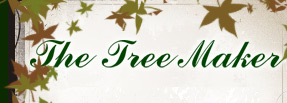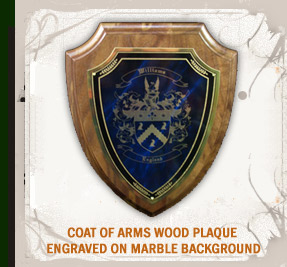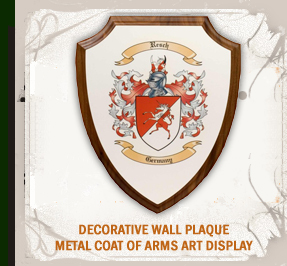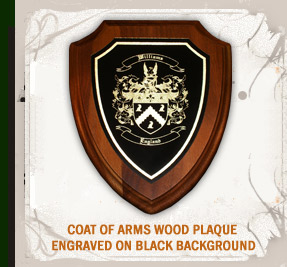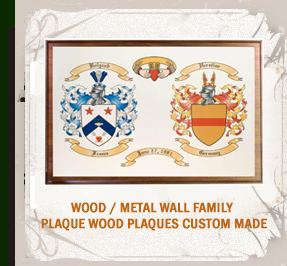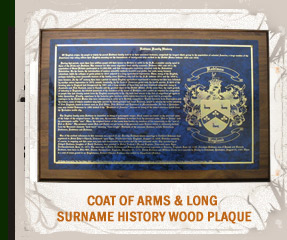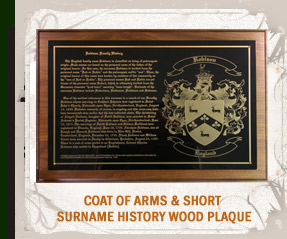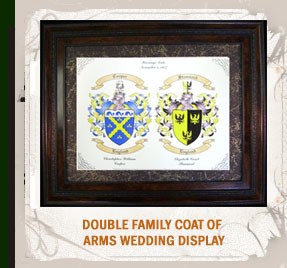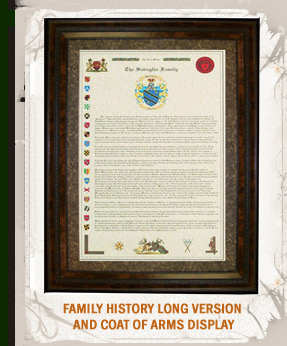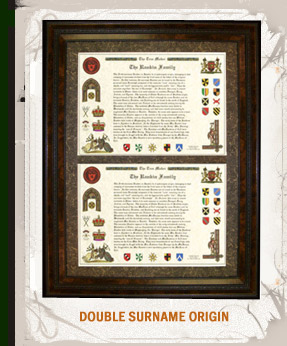Display your Irish coat of arms or your Ireland heritage
Early
Ireland History: By the start of the Christian Era the
various Celtic tribes inhabiting Ireland were apparently divided
into the five kingdoms of Ulster; Meath, Leinster, Munster, and
Connaught, whose rulers were subject to a high king dwelling at
Tara. The Druids, or priests, and the bards, who sang heroic tales,
were figures of special power and prominence in those early days.
In the fifth century, when St. Patrick carried on his famous missionary
work, Christianity became the religion of the island. Learning,
music, and poetry flourished; foreign students visited Ireland,
and Irish missionaries carried religion and scholarship to
England
and the Continent. This, Ireland's most glorious era, is the
period of which its people are most proud of their Irish heritage.
The
Invasion of Ireland; In 795 the Normans invaded Ireland,
settling along the coast and raiding the interior and its Irish
people. Two centuries later the country was temporarily united under
Brian Boroimhe {Brian Boru}, and in 1014 the Normans were finally
defeated at the Battle of Clontarf. In 1155, however, Pope Adrian
IV authorized Henry II of England to take Ireland as a papal fief,
and not long afterward an English army invaded Ireland to restore
Dermot MacMurrough, the deposed Kind of Leinster, to his throne.
Dermot's daughter married the English commander Richard Clare
"Strong bow", who inherited the crown on Dermot's
death. English soldiers and settlers occupied the eastern kingdom,
and Henry granted large estates in Ireland to English nobles. But
many of these immigrants adopted the ways and attitudes of the Irish
natives, and England soon controlled only a few towns and the Pale,
a district around Dublin.
Religious
Conflict of the Irish people; Henry VIII, who adopted the
title of King of Ireland in 1514, sought to make Ireland and it's
Irish countrymen, as well as England, Protestant. Destroying monasteries,
confiscating lands, and executing opponents, he launched a period
of violence in the Irish land that continued throughout the reign
of Queen Elizabeth I. Elizabeth made the Anglican Church the official
Church of Ireland; and it was during her reign that the Irish in
the northeast counties {Ulster} were driven out and their lands
settled by Protestant Scots. English authority spread, but Irish
resistance only increased. In 1641, 30,000 Protestants were killed
in an Irish uprising. Eight years later Oliver Cromwell's
invading army won temporary submission by means of mass slaughter
and unbelievable cruelty.
England's
James II, a Catholic, fled to Ireland after his abdication in 1688.
The Irish supported his plans to regain the throne, but in 1690
William of Orange {William III} led an army into Ireland and destroyed
James's forces in the Battle of the Boyne. The Scotch and
English of Ulster, allies of William, became known as Orangemen.
A treaty was drawn up, promising the Irish some rights and freedoms,
but it was rejected by the Parliaments of both lands. In this black
period, Irish immigrated to the American colonies in great numbers.
Political
Conflict in the Country of Ireland; In 1778 the Irish people
were given the right to acquire land, open schools, and exercise
their religion with fewer restrictions, but in 1800, after further
revolts, the Act of Union abolished the Irish Parliament, making
Ireland a part of the United Kingdom. Only Protestants represented
the country in the British Parliament until 1829, when the Emancipation
Act opened the way for Catholics to serve in the legislature. Daniel
O'Connell, who helped accomplish this reform, was one of the
leading Irish patriots of the period, as was the beloved Robert
Emmet, who was hanged after leading an unsuccessful rebellion in
1803.
To the poverty
caused by land and trade laws favoring English landowners, was added
in 1847-48 the terrible potato famine, which took a million Irish
lives within a few years and stimulated mass emigration to the United
States. Within a decade Ireland's population of eight million
was drastically reduced. The Irish-American Fenians inspired another
revolt in 1867, and Parliament passed some reform measures. By 1870
Ireland was demanding a native parliament to conduct its own internal
affairs. In the struggle for home rule, Charles Stewart Parnell
helped to win the support of the British Liberal party, which finally
lost control of the government because of its stand on Ireland.
After 1869 the
Anglican Church ceased to be the established church in Ireland.
In the next two decades land legislation improved the economic condition
of the farmers, and in 1898 local self-government was obtained.
Despite these reforms, however, agitation was revived under John
Dillon and John Redmond. In 1903 the Land Purchase Act made it possible
for Irish tenants to by land from the great landlords on easy terms.
Eleven years later a home-rule bill was passed which was later suspended
as a result of the protest of Northern Ireland and the outbreak
of World War I.
The
Final Struggle of the Irish People; On Ester Sunday, 1916
the Sinn Fein {Ourselves Alone} Society launched an uprising against
British rule. Although the revolt was soon crushed, the execution
of sixteen Irish rebels by the British won great popular support
for the revolutionary movement, and in the elections of 1918 the
Sinn Fein became the dominant Irish political party. Those elected
to Parliament met in Dublin in 1919 and declared Ireland a republic,
with Eamon de Valera as President. War broke out between the British
and the Irish republicans, who rejected the Government of Ireland
Act of 1920, granting Northern Ireland and the southern counties
separate parliaments as well as representation in the British Parliament.
To aid their soldiers, the British hired as special police the hated
Black and Tan, so called because they wore khaki uniforms and black
armbands and caps.
Prime Minister
Lloyd George finally called a peace conference, which in 1921 resulted
in the establishment of the Irish Free State as a self-governing
dominion. Refusing to join in this new arrangement, Northern Ireland
began its separate existence as a part of the United Kingdom.
From
Free State to Free Irish Nation; The less extreme Sinn
Feiners accepted the partition and in 1922 formed a provisional
government with Arthur Griffith, founder of the society, as President.
William T. Cosgrove became President of the permanent government
shortly afterward. In 1931 his followers, as the Irish Commonwealth
party, helped secure passage of the Statute of Westminster, which
gave the Free State the right to alter its relations with Great
Britain at will. In 1927 De Valera's group, the Fianna Fail
party, finally agreed to take part in the government, and in 1932
it gained control. De Valera, as President of the Executive Council,
set out to break all ties with Britain. One of his first moves was
to halt payments on land being bought from the British, thus launching
a serious trade war that lasted for six years.
Under a new
constitution adopted in 1937, the Irish Free State became "Eire",
"A sovereign, independent, democratic state". The next
year Dr. Douglas Hyde became Eire's first President and D
Valera its Prime Minister, and a British-Irish treaty involving
territorial, economic, and commercial arrangements brought an end
to the trade war. Although still a member of the British Commonwealth,
Eire remained strictly neutral in World War II; however thousands
of young Irishmen served with the British armed forces. In this
period Northern Ireland enjoyed a tremendous industrial boom, producing
ships and other war materials and providing bases for large Allied
contingents.
In 1945 Sean
T. O'Kelly, the Fianna Fail candidate, became Eire's
second President, but in the elections of 1948 the party lost control
of the government. It later returned to power. On Easter Monday,
April 18, 1949, the nation severed its last time with Great Britain
and became the Republic of Ireland.
Of course much
has changed since then and the nation of Ireland is a thriving country
proud of its heritage. Ireland is a place that you would be proud
to display your Irish genealogy, family coat of arms or surname
history.
